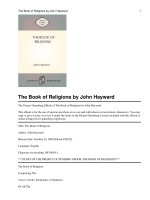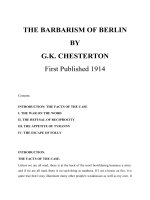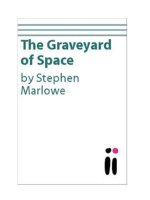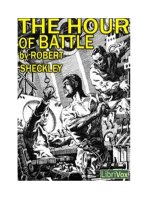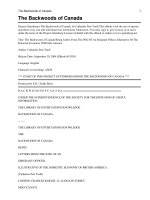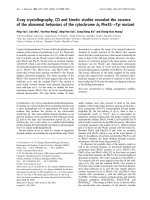Healing Presence: The Essence of Nursing potx
Bạn đang xem bản rút gọn của tài liệu. Xem và tải ngay bản đầy đủ của tài liệu tại đây (4.15 MB, 246 trang )
Healing Presence
The Essence of Nursing
JoEllen Goertz Koerner, RN, PhD, FAAN
NEW YORK
JOELLEN GOERTZ KOERNER, RN, PhD, FAAN, and founder of NurseMetriX,
is an author, editor, speaker, researcher, educator, and nurse executive leader of
international renown. She is the past president of the American Organization
of Nurse Executives (AONE) and 2005 recipient of the Lifetime Achievement
Award from the AONE Institute for Patient Care Research and Education. With
extensive executive-level management and leadership experience in health
care administration, education, regulation, and e-commerce, her initial career
efforts focused on nursing education and service in corporate health systems.
She then worked in virtual education with curriculum modeling and delivery
at the intersection of the philosophy and practice of professional nursing.
As founder of NurseMetriX, Dr. Koerner designed applications of corporate,
scientific, and information technology for Web-based innovations in the nurs
-
ing profession. Her international and voluntary work is focused on workforce
development for underrepresented sectors of society.
Healing Presence
The Essence of Nursing
Copyright © 2007 Springer Publishing Company, LLC
All rights reserved.
No part of this publication may be reproduced, stored in a retrieval system, or
transmitted in any form or by any means, electronic, mechanical, photocopying,
recording, or otherwise, without the prior permission of Springer Publishing
Company, LLC.
Springer Publishing Company, LLC
11 West 42nd Street
New York, NY 10036
www.springerpub.com
Acquisitions Editor: Sally J. Barhydt
Production Editor: Carol Cain
Cover design: Mimi Flow
Covert Art: David Stirts
Composition by Apex Publishing, LLC
07 08 09 10/ 5 4 3 2 1
Library of Congress Cataloging-in-Publication Data
Koerner, JoEllen Goertz.
Healing presence : the essence of nursing / JoEllen Goertz Koerner.
p. ; cm.
Includes bibliographical references and index.
ISBN-13: 978-0-8261-1575-1 (alk. paper)
ISBN-10: 0-8261-1575-6 (alk. paper)
1. Nursing—Psychological aspects. 2. Healing—Psychological
aspects. 3. Holistic nursing. 4. Nurse and patient. I. Title.
[DNLM: 1. Nursing Care—methods. 2. Mind-Body and Relaxation
Techniques—nursing. WY 100 K78h 2007]
RT86.K6448 2007
610.73—dc22
2007005727
Printed in the United States of America by Bang Printing.
This book is dedicated to the Universal Spirit that unites and heals us all.
vii
Contents
Preface: An Invitation xi
Acknowledgments xv
Foreword: Reflections of a Nurse Healer by Julie MacDonald xvii
Section I. Introduction
CHAPTER 1. Nursing: A Sacred Work 3
A Return of the Feminine Healing Energy
Worldview: Individual Perspective on How Life Works
Healing Presence: Ground, Field, and Witness
The Nursing Triad: A Model for Healing
Science: The Foundation of Knowledge, Which Guides
Our Practice
Art: The Intuitive Skill of Clinical Reasoning
Essence: The Authentic Healing Presence of the Nurse
Self-Knowledge: The Key to Healing Presence
Section II. The Healing Field: The Context
for Nursing Practice
CHAPTER 2. The Noetic Scientist: A Holistic Worldview 21
Expanding Our Science: Holism vs. Reductionism
Enlarging Our Practice: Expansive Scientific Models
Recreating Our Reality: Nurses As Noetic Scientists
CHAPTER 3. The Creative Artist: Composing a Life 31
Art: The Power of Perspective
Multidimensionality: The Influence of Time and Space
Pattern: The Power of Limits
Integration: The Art of Living
CHAPTER 4. The Human Essence: Unfolding Inner
Potential 47
Our Beginnings: A Slow and Solitary Journey
Sharing the Path: A Convergence of Collectives
Expanding Understanding: Movement From Religious to Secular
The Possible Human: A Biology of Transcendence
Section III. A Healing Presence: The Power of One
CHAPTER 5. Vibrant Health: The Path of Balance 65
Health Beliefs: Living Our Definitions
The Human Body Re-Envisioned: An Integrated Field of
Energy
The Human Mind Re-Envisioned: An Expansive Field of
Consciousness
Balance: The Key to Vibrant Well-Being
CHAPTER 6. Quantum Healing: The Path of Integration 95
The Healing Process: Re-establishing Flow
The Healing Path: Stages of Integration
Stage I: Embracing Our Suffering
Stage II: Transcending Our Polarities
Stage III: Moving Towards Authenticity
Stage IV: Enhancing Capacity
Stage V: Emptiness Moving Towards Integration
Stage VI: Shifting the Focal Point
Stage VII: Returning to Community
CHAPTER 7. Healing Presence: The Path of Engagement 115
Spiritual Dimensions of Nursing: Presence and Wisdom
Active Observation: Seeing Beyond the Obvious
Active Intelligence: Knowing Beyond Concrete Thought
Active Receptivity: Being Present With Authenticity
Becoming a Healing Presence
Section IV. A Healing Path: Weaving a Purposeful Life
CHAPTER 8. Authentic Living: The Path of Becoming 141
Expanding Consciousness: A Shift in Values
A Balanced Values Matrix: Integrating the Personal and
Professional
viii Contents
Seven Stages of Personal Development: Living From a
Foundation of Balance
Values Matrix—The I-MAP
Seven Stages of Professional Development: Practicing From
the Perspective of Mastery
Personal/Professional Development Exemplar
Seven Stages of Self-Management and Leadership: Leading
From the Power of Authenticity
Leadership Development Exemplars
Bringing Our Souls to Work: Practicing From a Balanced
Center
CHAPTER 9. Healing Virtues: Expressions of the Soul 173
Phase I: Information—The World As Mirror
Virtue #1: Conscious Living—Living the
Examined Life
Virtue #2: Vibrant Health—Being the Change You
Want to See in the World
Virtue #3: Focused Clarity—Seeing the Whole Rather
Than the Hole
Phase II: Knowledge—Lived Experience As Teacher
Virtue #4: Reverence for All Life—Holding
an Interconnected View of the Universe
Virtue #5: Authentic Presence—Being Real
So Others Can Show Up Also
Virtue #6: Creative Imagination—Opening Space
for Spontaneous Creation to Emerge
Phase III: Wisdom—Present Moment As Guide
Virtue #7: Courageous Vigilance—Bearing Witness
to Suffering With Merciful Detachment
Virtue #8: Elegant Timing—Practicing Effortless
Learning and Living
Virtue #9: Compassionate Caring—Experiencing
Nonjudgment and Forgiveness for All
Phase IV: Mystery—The Unknown As Inspiration
Virtue #10: Learned Ignorance—Releasing the Need
for Certainty and Predictability
Virtue #11: Active Surrender—Utilizing the Power of
Paradox
Virtue #12: Mindful Awareness—Stepping Out of
the Mind’s Contents Into the Moment With
Fresh Eyes
Contents ix
CHAPTER 10. Healing Web: Weaving the Web of Life 197
Weaving the Web of Your Life
Transpersonal Nursing: Being a Healing Presence
1. Health and Well-Being Unfold Between One Nurse
and One Patient in Each Authentic Encounter
2. Reflective Practice Is the Hallmark of an Authentic Nurse
3. Authentic, Reflective Practice Enhances
Potential for Intuition and Creativity
4. Intuitive Practice Facilitates the Uncovering
of Meaning in the Illness Event
5. Compassion Creates the Context for Transpersonal Caring
Transforming Ourselves
Afterword 213
Glossary of Terms 215
Index 219
x Contents
xi
Preface
AN INVITATION
Through a long and rewarding career in nursing I have been privileged to
support and learn from many about the wellness-illness patterns that mark
the human experience. It is frequently an illness event that slows us down, in
-
viting us to step outside normal routines to reevaluate the beliefs and patterns
that create the life we live. Cares of the day become insignificant when one is
confronted with one’s mortality. The focus shifts to the deeper questions of
the soul.
Occasionally when we are ill, we are fortunate enough to have the support
and safety of a caring relationship in which we can ponder with vulnerability
and reflect with candor on our fundamental beliefs, our assumptions and ex
-
pectations for ourselves and others. We begin to sort through the panorama of
lived experiences we have encountered and discern how we have used them to
understand and ascribe meaning to life as a whole and to our life specifically.
Nursing education taught me skills in assessment and intervention to re
-
lieve suffering and promote healing of the body. Experiences as a middle child
helped me develop a deep intuition about what was central to the issue at
hand when viewpoints varied. The resulting capacity of managing subtly by
hearing behind the words and seeing beneath the action helped facilitate clar
-
ity for myself and others. However, later in my career, as I was caring for my
daughter in her near-death experience, she taught me a deeper and richer
way of being with people. From her I truly came to understand what creates
a healing environment for people faced with a health crisis, and we both be
-
came more in the exchange.
It is humbling to realize how little our external efforts impact healing.
True healing versus physical curing arises from an internal mechanism re
-
siding within the soul of each of us. This innate capacity is enhanced when
recognized and honored by one who offers a healing presence in the caring
experience. Many individuals from all walks of life have served as witness
and support for someone suffering, facilitating that healing force within their
loved one. So it is with profound respect for the power of love to heal that I
have created this book on healing presence.
Nursing is at the crossroads, facing shortages of unparalleled proportion at
a time when society is experiencing health care challenges of great magnitude.
As older nurses retire, the next generation is nowhere evident. The nursing
profession has spent so much effort in the recent past to attain scientific le
-
gitimacy within the health care industry that the core essence of the discipline
has been misplaced. At the
center of professional nursing lies the authentic
presence of the nurse, the intent and commitment that brings the nurse to the
profession in the first place. When there is congruence between who they are
and what they do, nurses bring their souls to work. This balance is experi
-
enced as a healing presence that potentiates the patient’s self-healing capacity.
Both the nurse and patient experience meaning in their exchange and each
becomes more whole.
This book is designed to place twenty-first-century nursing into a timeless
paradigm, one that transcends the economic, political, and technological cul
-
ture of the day. It is important to remember that nursing is a social mandate
and has been part of the communal fabric since the dawning of civilization.
Birth, death, and health-illness are a part of the legacy of humankind, which
requires the assistance of others. Exciting developments in science and tech
-
nology have made the role of the nurse richer and more complex. We now
have an array of tools and services to offer those we care for that were not
possible for our predecessors. But the unifying, underlying essence of our
work is the timeless and profound healing presence we offer that enhances the
exploration and creation of meaning in the inevitable health challenges faced
by individuals, families, and groups whose lives we are privileged to touch.
This offering is a compilation of information and insights accrued as I tra
-
versed a professional journey. In the early stages of my chosen vocation, I
quickly discovered that nursing is truly an art as well as a science; information
needed interpretation for appropriate application. My interests in both were
met with another realization that, at its core, nursing called for something
more. It required an exchange of the human spirit.
Through the years, my study became increasingly focused on the emerging
fields of quantum science, philosophy, and metaphysics. In that juncture of
body-mind-spirit a synthesis of wholeness was finally grasped. The underlying
philosophy expressed in this book reflects an appreciation of, and a place for,
all aspects of life and human endeavor. Because life is so big, and the world
becoming increasingly small, the beliefs and values of all we serve in nursing
are asking to be recognized, respected, and honored in our awareness and our
healing work.
Although theories come and go in just a few centuries or even decades,
inklings of the mystical are found in the writings of great personalities the
world over. People like Einstein, William Blake, and Carl Jung have modeled
xii Preface
that deep thought is always inspired from within. Their reflections are woven
throughout the scientific exploration undertaken here as an effort to interweave
the philosophical and spiritual into our predominant frame of reference.
Growing up in a small rural community of 1,000 people, I discovered the
power of the written word. I quickly learned that through a book one could
engage in an inner dialogue with people across time and distance. This book is
not meant to be a comprehensive scientific review, but rather an introduction
to conversations with some of the finest minds in existence. It is a small effort
to introduce you to my friends (as noted in the many references inviting you
to join their dialogue). It is an invitation to remember your call to nursing, to
reengage with the passion and commitment that inspired you. It is a statement
of gratitude for all you have contributed to the life of humankind in general,
and mine in particular. It is a celebration of the power of the human spirit
that is manifest everywhere we practice. And it is a statement of gratitude to
All-That-Is for the privilege of sharing the life journey with so many at this
time in history.
Ask that I may be forgiven if my pen
has gone astray or my foot has slipped,
for to plunge into the abyss of the Divine
Mysteries is a perilous thing and no easy
task is it to seek to discover the Unclouded
Glory which lies behind the veil.
Al-Ghazali
JoEllen Goertz Koerner
Preface xiii
xv
Acknowledgments
A debt of gratitude is expressed to all who have gone before, creating
the current path unfolding. I am indebted to Dr. Bruce Fisher and Donna
Ehrenreich for their wisdom, insight, and candor in shaping the manuscript.
Deep admiration is extended to David Stirts for creating beautiful tapestries
that reflect the essence of concepts being considered. Finally and foremost,
profound appreciation and devotion is felt for my personal and professional
families, whose love, guidance, and unconditional support have been a sus
-
taining and healing presence in my life.
A disclaimer:
Many quotes offered in this book have been collected throughout my career
from presentations, writings, and conversations with colleagues and kept in
a small file in my desk called “Inspiration.” While I cannot always find the
originating source of these encouraging messages, when possible I have pro
-
vided the authors’ names as an invitation to the reader to explore their wise
and rich words.
xvii
Foreword
REFLECTIONS OF A NURSE HEALER
…and at the end of all our exploring will be to arrive where we started … and
to know the place for the first time.
T. S. Eliot
Little Gidding
All nurses, regardless of our career paths, have at one time or another enjoyed
the privilege of sharing our healing presence with patients. This opportunity
to contribute to the patient’s health and well-being using compassion and
empathy has been what most nurses would say drew them into the profession.
This call to our work, acknowledged as timeless, has not really had the center
stage it might, given its magnetic pull to the profession. As a matter of fact,
in my 35 years as a nurse I have seen the topic of nursing’s essence discussed
more when the profession was near a drought either in recruits or in role
satisfaction. Our cyclical conversations have been inadequate for such an im
-
portant cornerstone of nursing’s work. It seems the energy so needed to fuel
the profession lies deep in this aspect of our work. How we can collectively
learn to more effectively use it is key.
Drilling Down to the Essence
I have often viewed and described the work of nursing in two dimensions,
doing and being. All nurses understand the doing dimension of nursing. So
much of a nurse’s preparation, socialization, and role definition lies in what
nurses do. The doing skills and technical accountabilities are what keep
nurses running and very busy. This dimension of nursing’s work has clear
-
ly changed, grown, and become more complex over time. Doing is clearly
more concrete, measurable, and generally what has been perceived to be the
valued aspect.
The being dimension of the role of nurse is less about what nurses do and
more about the how. The focus of being and how the nurse comes to the
bedside receives less time in a nurse’s preparation, socialization, and even
role definition. Admittedly, this being dimension is more difficult to describe,
harder to measure, and although valued by nurses and those patients who
benefit from it, has not always been at the center of what is rewarded. Being
is what slows down the nurse so that space is created for an authentic, deep
connection with the patient and healing. The work of being has remained
constant over time. Embedded in the being dimension of the role lies the es
-
sence of nursing, and it is here that the call to the profession is actualized.
One might say that over my career I have had a preoccupation and con
-
versation around the essence of nursing. When years have passed since I have
seen certain colleagues and we end up in conversation about nursing, I am
certain they say, “she’s still at it.” I even bore myself at times. Nevertheless,
bringing focus and language to this being dimension has been my lifelong
work.
Ten years into my nursing career while in graduate school I fell deeply
into the study of the humanistic psychologists, particularly Carl Rogers. His
theories and writings, On Becoming a Person, and Person Centered Approach,
brought me a new perspective on the being aspect of my bedside practice.
The biggest shift was looking inward at myself first before looking at how I
might be more effective in working with others. Rogers’s delineation of the
conditions necessary for this deep connection with patients gave me a loom
into which to weave the threads of my work about being. These conditions of
genuineness, acceptance, and empathetic understanding were fitting for the
preparation of coming to the bedside to be fully present for the patient. One
might even say that for nurses these conditions are obligatory in occupying
the space for healing with patients.
As nurses we have been taught and have learned a fair amount about the
importance of empathy. We have witnessed its effect on patients and learned
from our experiences, and nurses have earned well-deserved credibility in its
delivery. We have spent little time, however, on our individual development
of genuineness and acceptance. It is as if once we have received the call into
nursing these two other qualities were assumed to be in place. Nurses, as great
as we might be in the eyes of those we serve, are as human as anyone. As such,
we come with our own individual work to do as we journey toward our po
-
tential. Seated so close to the patient in the practice of nursing, this individual
obligation takes on crucial importance.
The condition of being genuine in our relationships with patients and oth
-
ers seems welcoming. What an invitation to be who I am, which is not as
simple at times as it may seem. Besides acknowledging our humanness, being
genuine implies a deep awareness and knowledge of self. Moreover, it calls
for an appreciation of self with all the beauty and bruises that our true self
reflects. The acceptance of our self as imperfect creates the capacity to be more
open, transparent, and vulnerable. This authenticity plays a key role in how
xviii Foreword
we are seen and experienced by others. Being genuine is a necessary condition
in order for others to be real with us.
I have found Rogers’s second condition of acceptance dependent on the
capacity to be genuine. When I am accepting of my true self, I am more ac
-
cepting of others and where they are. Just as self-acceptance implies being free
from preconceived notions about myself, accepting others requires the giving
up of any bias or predetermined perceptions about where others should be.
This means no prejudice, labels, or judging of others. It is only when we are
fully accepting of our true selves that we are able to be fully open to accepting
others. The gift of acceptance is the nurturant space it creates for others to
discover more of their true selves.
One can easily see how development of a nurse’s capacity for genuineness
and acceptance influences the capacity for Rogers’s third condition of empa
-
thetic understanding. The ability to understand and to feel the patient’s jour
-
ney, struggle, and emotions, as the patient experiences them, is the ultimate
privilege of the role of nurse. This is not new territory for nurses. Capacity,
however, will be enhanced, perhaps even transformed, with a deeper self-
knowledge, acceptance, and new awareness.
This journey with self opens one’s eyes to see new potential. We as nurses
can well imagine the impact it could have in serving patients. Can we imagine
at the same time the new potential and energy that would be created with
renewed wholeness in nurses and nursing? The answer lies in our individual
and collective willingness to claim, embrace, and become our essence . . . one
nurse at a time.
Walk slowly with intent, courage and a sense of inquiry through the
pages of wisdom that follow. JoEllen Koerner, one of nursing’s most
entrusted friends and healers, is our guide to discovery and coming
home.
Julie MacDonald, RN, MSN
Chief Operating Officer
St. Joseph Mercy Healthcare System
Foreword xix
S E C T I O N I
Introduction
Fear not the strangeness that you feel.
the future must enter you
long before it happens.
Just wait for the birth,
for the hour of new clarity.
Rainer Maria Rilke
3
CHAPTER 1
Nursing
A Sacred Work
To possess the will that nurses our visions &
brings us closer to the path of angels,
that infuses us with compassion &
makes us glow like a soft amber—
that is the secret of wisdom.
Henryk Skolimowski
The profession of nursing is a tribe, complete with our own culture, customs,
and mores. Early tribal groups found strength and flexibility through the
differentiation of task and orientation as hunter-gatherers, artisans, and healers
shared in caring for the needs of the community. So too, contemporary nursing
is offered by practitioners with a bias for the rigors of science, the aesthetics of
artistic expression, or the meaning of spiritual orientation. Individually and col
-
lectively our differences converge on a shared mission, the support of healing
on this planet.
This book is an invitation to examine our world and our work from
the multiple perspectives of our clan. Given the multifaceted nature of the
topic and the tribe, this offering is comprised of various perspectives and
interweaving themes. The voices and viewpoints are varied, creating a mosaic
of models and metaphors that speak to our differing orientations to the role.
Reflections and insights from colleagues give depth and meaning to our shared
experience of caring.
This book is a composite of findings and innovations grouped into various
orientations that may best fit your particular worldview. For the quintessential
nurse scientist, the first section of this offering focuses on the unfolding discov
-
eries of quantum physics and our understanding of health and illness from the
new science perspective. Section II looks at health and healing through the lens
of philosophy and spirituality, identifying new models for transpersonal caring.
The final section of this book speaks to nursing practice from the perspective of
beliefs and values, and the artistic cocreative activity of choice and action.
Feel free to wander through the rich tapestry woven from threads of insight
given by so many courageous pioneers in the healing field. Add your own discov
-
eries and wisdom as you reflect on your call to the profession, your experiences,
your insights, and your aspirations. Share them with colleagues as we cocreate
the context and the processes for our sacred and ever-unfolding work.
A RETURN OF THE FEMININE HEALING ENERGY
We are living in a most extraordinary and opportune time, as the world faces
a crucial juncture in the history of humankind. While the last Renaissance
focused on the merging of art and science, this current awakening includes the
illumination of our personal philosophy, the embracing of our own wisdom.
We are poised to come home; to embrace the essence of our own wholeness.
As we continue into the new millennium, some of us sense that this is a
major turning point in the long human journey. As we perceive the difference
between the superficial and the substantive, we recognize what is being born
while surrounded by what is dying. To witness life at this level, we must view
the process from soul territory. Fortunately, we are no strangers here. This is
the very center of the nursing domain.
The epoch of nursing began with the inhalation of the first breath of
humankind. It is a story of presence and support, defined by witness and
engagement, guided by compassion and caring. Ours is a story filled with
ethos, intrigue, breakthroughs and setbacks, moments of beauty and periods
of darkness. It is a story of the feminine healing energy moving through the
ages. This pattern forms a seed-crystal for the notion of watchfulness; the
practice of seeing and being seen by the Source.
On the physical level our portals of observation include two eyes, two ears,
two nostrils, and a mouth. Yet, inherent in the feminine healing energy is the
subtle ability to see fully with an “unseen eye”—to take in the whole—with a
compassionate, caring heart, and detached vision.
Paradoxically, the ever-expanding field of classical science focused on
masculine qualities is couched in the oft unseen field of feminine energy, the
most essential element in the healing journey. For those we are privileged to
serve, we provide the “source of mercy that helps others untie their tangles”
(Briskin, 2005). Such is the nature of the realm of active receptivity, the sacred
essence of nursing.
4 Healing Presence
Chapter 1. Nursing 5
Unlike Western society, other cultures honor the place of the feminine
function in their stories. In Hindu legend, the Seven Rishi look and watch
over the whole of the universe. Jewish tradition refers to the Seven Eyes of
God looking out upon the world.
This way of seeing and being requires a specific responsibility for watching
over things of the soul. Such a witness takes us deep into the farthest reaches
of perception and consciousness. Seeing fully takes us to the essence of our
higher selves, that which is our connection point to All-That-Is. From this
portal we recognize that there is something we all know that deepens our
identification with others and the very earth itself. We come alive with feeling,
sensing the unbroken consciousness that creates a vibration of shared mean
-
ing that flows as an expression of heart, mind, and will. This is the space of
active receptivity.
Such a place prompts an apprehension of wholeness, which is the receptive
feminine function in the universe. Reb Zalman observed:
The other thing that is necessary is to have women involved. Because it’s in
the nature of the masculine vision to see the figure and ignore the ground.
In other words that which is erect and that which enters and that which has
power, and that which deposits sperm, and that which is active, and so on
and so forth. (Cited in Briskin, 2005, p. 9)
Too often there is an ignoring of those who receive, or contain, or hold.
Much focus is placed on the object, leaving little awareness of the field in
which it sets. One sees the black letters on the page without conscious recog
-
nition of the white space that surrounds them. Reb Zalman continues:
I can’t see the wind, but I see the flag in the wind… . Though I don’t see
the wind I see the flag moving. I understand that what I’m seeing is not
just the flag, but it’s flag and wind… . In similar fashion when I look at
a river, it’s the bed and it’s the water. But river is the bed and the water
together; it’s the figure and ground together.
The active element of receptivity, this feminine function, fosters the con-
struct of wholeness by making the object or event more than simply an inter
-
relationship of parts. It is the active principle of wholeness, a figure-ground
dynamic that exposes this invisible half, the one that gives context and mean
-
ing to that which it gently uplifts and holds. And in this undivided space, we
are complete.
Many nursing actions take place against a background invisible to the eye not
attuned to its subtle presence. To be truly conscious of the essence of the total
experience is to continually seek the invisible half of wholeness. Here we uncover


